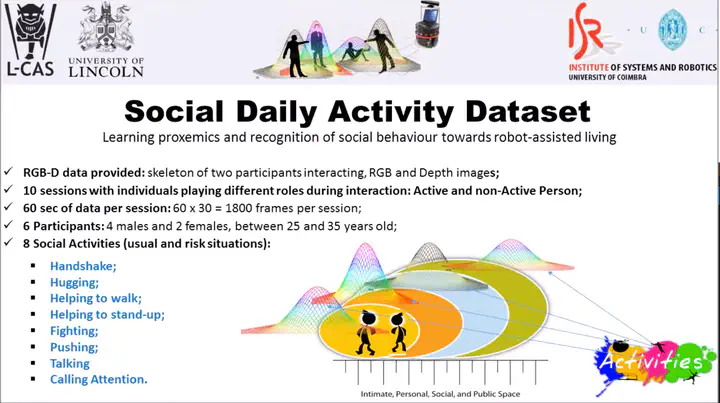 Screenshot of the training environment.
Screenshot of the training environment.This is a social interaction dataset between two subjects. This dataset consists of RGB and depth images, and tracked skeleton data (i.e. joints 3D coordinates and rotations) acquired by an RGB-D sensor. It includes 8 social activities: {handshake, greeting hug, help walk, help stand-up, fight, push, conversation, call attention}. Each activity was recorded in a period around 40 to 60 seconds of repetitions within the same session at a frame rate of 30 frames per second. The only exceptions are help walking (at a short distance) and help stand-up, which were recorded 4 times to the same session, regardless of the time spent on it.
The activities were selected to address the assisted living scenario (e.g. happening in a health care environment: help walking, help stand-up and call attention), with potential harm situations, such as aggression (e.g. fighting, pushing), and casual activities of social interactions (e.g. handshake, greeting hug and conversation). The activities were performed by 6 persons, 4 males and 2 females with an average age of 29 years old, from different nationalities (Italian, Brazilian and Portuguese). A total of 10 different combinations of individuals (or sessions) were performed, with variation of the roles (active or passive person) between the subjects. Each subject has participated at least with 3 combinations, acting each role at least once. Half of the recorded sessions have been performed by a pair of persons whom never met before the interaction, This was done in order to increase the generalization of the study regarding individual behavior.
Dataset structure, download and conditions of use
The dataset is composed of 10 sessions. Each session provides RGB-D images and skeleton tracks of 8 different activities performed by two people. Each session is zipped in a separate file, which contains a folder that has skeleton tracks in a text format and RGB (24 bits) and depth (both 8 and 16 bit resolution) images. Each row of the skeleton text file contains information about positions (6 DoF) of 15 joints.
@INPROCEEDINGS{Coppola2016a,
author = {C. Coppola and D. Faria and U. Nunes and N. Bellotto},
title = {Social Activity Recognition based on Probabilistic Merging of Skeleton
Features with Proximity Priors from RGB-D Data},
booktitle = {Proc. of IEEE/RSJ Int. Conf. on Intelligent Robots and Systems (IROS)},
pages = {5055-5061},
year = {2016}
}
Institute of Systems and Robotics (ISR-UC), University of Coimbra, Portugal and L-CAS, University of Lincoln, UK. Contact: Claudio Coppola, PhD Candidate ccoppola@lincoln.ac.uk – Dr Diego R. Faria d.faria@aston.ac.uk – Dr Nicola Bellotto nbellotto@lincoln.ac.uk